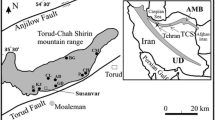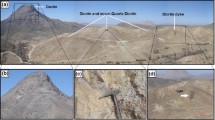Abstract
Quantitative descriptions of geochemical patterns and providing geochemical anomaly map are important in applied geochemistry for mineral exploration and environmental assessment. To identify and separate geochemical anomalies, several statistical methodologies (nonstructural and structural) are presented by researchers. The Gap statistic method is a traditional approach which does not depend on the location of samples. This method is one of the univariate methods which assess the threshold based on one variable (one element). In this study, the Gap statistic applied on grade values of samples for separating anomaly from background in the case of Au and As resulted from surface sampling in Susanvar district, Iran. Then, this method is employed to delineation geochemical anomalies in multivariate mode using Euclidean distance. Finally, bivariate geochemical anomaly map is provided for Au and As using multivariate Gap statistic method. Results show that dispersion of the anomalous samples indicated by this method has decreased and they are located near each other in comparison with other univariate nonstructural ones. Also, it is seen that performance of Gap statistic method is increased for estimating threshold and separation in multivariate mode using Euclidean distance. So that, prepared mineral potential map for Au and As using multivariate Gap statistic shows that anomalous area is corresponded to Au occurrences in the region.
Similar content being viewed by others
References
Afzal P, Khakzad A, Moarefvand P, Rashidnejad Omran N, Esfandiari B, Alghalandis YF (2010) Geochemical anomaly separation by multifractal modeling in Kahang (Gor Gor) porphyry system, central Iran. J Geochem Explor 104:34–46
Agterberg FP (2013) Fractals and spatial statistics of point patterns. J Earth Sci 24(1):1–11
Bodenan F, Baranger P, Piantone P, Lassin A, Azaroual M, Gaucher E, Braibant G (2004) Arsenic behaviour in gold-ore mill tailings, Massif Central, France: hydrogeochemical study and investigation of in situ redox signatures. Appl Geochem 19:1785–1800
Box GEP, Cox DR (1964) An analysis of transformations. J R Stat Soc Ser B26:211–252
Cheng Q (1999) Spatial and scaling modelling for geochemical anomaly separation. J Geochem Explor 65(3):175–194
Cheng Q, Agterberg FP, Ballantyne SB (1994) The separation of geochemical anomalies from background by fractal methods. J Geochem Explor 51:109–130
Cheng Q, Agterberg FP, Bonham-Carter GF (1996) A spatial analysis method for geochemical anomaly separation. J Geochem Explor 56:183–195
Cheng Q, Yaguang X, Eric G (2000) Integrated spatial and spectrum method for geochemical anomaly separation. Nat Resour Res 9(1):43–52
Filzmoser P, Hron K (2013) Robustness for compositional data. In: Becker C, Fried R, Kuhnt S (eds) Robustness and complex data structures, festschrift in honour of ursula gather. Springer, Heidelberg, pp 117–131
Ghannadpour SS, Hezarkhani A (2012) Determine the initial statistical specifications of Copper and molybdenum elements in Porphyry Copper ore deposit in Kerman. In: International mining congress and exploration, Iran (in Persian)
Ghannadpour SS, Hezarkhani A (2015a) Investigation of Cu, Mo, Pb, and Zn geochemical behavior and geological interpretations for Parkam porphyry copper system, Kerman, Iran. Arab J Geosci 8(9):7273–7284
Ghannadpour SS, Hezarkhani A (2015b) Lead and zinc geochemical behavior based on geological characteristics in Parkam Porphyry Copper System, Kerman, Iran. J Cent South Univ 22(11):4274–4290
Ghannadpour SS, Hezarkhani A (2016a) Introducing 3D U-statistic method for separating anomaly from background in exploration geochemical data with associated software development. J Earth Syst Sci 125(2):387–401
Ghannadpour SS, Hezarkhani A (2016b) Exploration geochemistry data-application for anomaly separation based on discriminant function analysis in the Parkam porphyry system (Iran). Geosci J 20(6):837–850
Ghannadpour SS, Hezarkhani A (2017) Comparing U-statistic and nonstructural methods for separating anomaly and generating geochemical anomaly maps of Cu and Mo in Parkam district, Kerman, Iran. Carbonate Evaporites. 32(2):155–166
Ghannadpour SS, Hezarkhani A (2018) Providing the bivariate anomaly map of Cu–Mo and Pb–Zn using combination of statistic methods in Parkam district, Iran. Carbonate Evaporites 33(3):403–420
Ghannadpour SS, Hezarkhani A, Maghsoudi A, Farahbakhsh E (2015a) Assessment of prospective areas for providing the geochemical anomaly maps of lead and zinc in Parkam district, Kerman, Iran. Geosci J 19(3):431–440
Ghannadpour SS, Hezarkhani A, Sabetmobarhan A (2015b) Some statistical analyses of Cu and Mo variates and geological interpretations for Parkam porphyry copper system, Kerman, Iran. Arab J Geosci 8(1):345–355
Ghannadpour SS, Hezarkhani A, Sabetmobarhan A (2017a) The Parkam exploration district, Kerman, Iran: geology, alterations, and delineation of Cu-and Mo-mineralized zones using U-spatial statistic with associated software development. J Earth Sci 28(2):283–294
Ghannadpour SS, Hezarkhani A, Roodpeyma T (2017b) Combination of separation methods and data mining techniques for prediction of anomalous areas in Susanvar, Central Iran. J Afr Earth Sci 134:516–525
Ghannadpour SS, Hezarkhani A, Sharifzadeh M (2017c) A method for extracting anomaly map of Au and As using combination of U-statistic and Euclidean distance methods in Susanvar district, Iran. J Cent South Univ 24(11):2693–2704
Ghannadpour SS, Hezarkhani A, Sharifzadeh M, Ghashghaei F (2019) Applying a structural multivariate method using the combination of statistical methods for the delineation of geochemical anomalies. Iran J Sci Technol Trans A Sci 43(1):127–140
God R, Zemann J (2000) Native arsenic-realgar mineralization in marbles from Saualpe, Carinthia, Austria. Mineral Petrol 70:37–53
Goncalves MA, Mateus A, Oliveria V (2001) Geochemical anomaly separation by multifractal modeling. J Geochem Explor 72:91–114
Hawkes HE, Webb JS (1962) Geochemistry in mineral exploration. Harper and Row, New York, p 415
Hezarkhani A, Ghannadpour SS (2015a) Exploration information analysis, 1st edn. Amirkabir University of Technology (Tehran Polytechnic) Press, Tehran (in Persian)
Hezarkhani A, Ghannadpour SS (2015b) Geochemical behavior investigation based on K-means clustering (basics, concepts and case study), 1st edn. LAP LAMBERT Academic, Germany
Kramar U (1995) Application of limited fuzzy clusters to anomaly recognition in complex geological environments. J Geochem Explor 55:81–92
Li C, Ma T, Shi J (2003) Application of a fractal method relating concentrations and distances for separation of geochemical anomalies from background. J Geochem Explor 77:167–175
Merino DI (2002) The distance between a point and a line using different norms. Southeastern Louisiana University, Cadence Lee Ellington, pp 1–2
Miesch AT (1981) Estimation of the geochemical threshold and its statistical significance. J Geochem Explor 16:49–76
Nguyen TT, Vu DT, Nguyen TLH (2016) Spatial cluster and outlier identification of geochemical association of elements: a case study in juirui copper mining area. Bull Miner Res Explor 153:159–167
Rousseeuw PJ, Croux C (1993) Alternatives to the median absolute deviation. J Am Stat Assoc 88(424):1273–1283
Sabet-Mobarhan-Talab A, Alinia F, Ghannadpour SS, Hezarkhani A (2015) Geology, geochemistry, and some genetic discussion of the Chador-Malu iron oxide-apatite deposit, Bafq District, Central Iran. Arab J Geosci 8(10):8399–8418
Shamanian GH, Hedenquist JW, Hattori KH, Hassanzadeh J (2004) The gandy and abolhassani epithermal prospects in the Alborz Magmatic Arc, Semnan Province, Northern Iran. Econ Geol 99:691–712
Sinclair AJ (1989) Application of probability graphs in mineral exploration. In: The association of exploration geochemists, the association of exploration geochemists, 4th edn
Sinclair AJ (1991) A fundamental approach to threshold estimation in exploration geochemistry: probability plots revisited. J Geochem Explor 41(1):1–22
Stanley CR, Sinclair AJ (1989) Comparison of probability plots and the gap statistic in the selection of thresholds for exploration geochemistry data. J Geochem Explor 32:355–357
Thornton I, Farago M (1997) The geochemistry of arsenic. In: Abernathy CO, Calderon RL, Chappell WR (eds) Arsenic exposure and health effects. Chapman & Hall, London, pp 1–16
Tien TN (2017) Use of Moran’s I and robust statistics to separate geochemical anomalies in Jiurui area (Southeast China). Bull Miner Res Explor 156:22–44
Yang ZY, Pourghasem HR, Lee YH (2016) Fractal analysis of rainfall-induced landslide and debris flow spread distribution in the Chenyulan Creek Basin, Taiwan. J Earth Sci 27(1):151–159
Zuo R (2011) Identifying geochemical anomalies associated with Cu and Pb–Zn skarn mineralization using principal component analysis and spectrum-area fractal modeling in the Gangdese Belt, Tibet (China). J Geochem Explor 111:13–22
Acknowledgements
This revised version has greatly benefited from the insightful, constructive comments the Associate Editor and reviewers kindly provided. We are grateful to the Geological Survey of Iran and Kavesh Kansar Engineering Company for sampling operations; and to Ms. Fatemeh Ghashghaei for giving us data about Susanvar region.
Author information
Authors and Affiliations
Corresponding author
Additional information
Publisher's Note
Springer Nature remains neutral with regard to jurisdictional claims in published maps and institutional affiliations.
Rights and permissions
About this article
Cite this article
Ghannadpour, S.S., Hezarkhani, A. Mineral potential mapping for Au and As using Gap statistic method in multivariate mode. Carbonates Evaporites 35, 2 (2020). https://doi.org/10.1007/s13146-019-00546-8
Accepted:
Published:
DOI: https://doi.org/10.1007/s13146-019-00546-8














